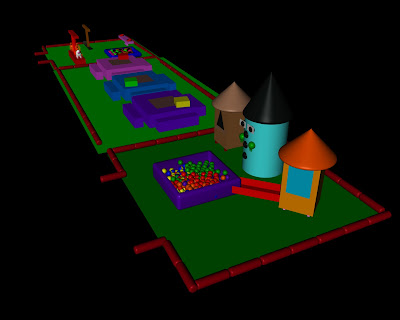

 Why is the playgrounds not good and does not cater to the needs of children ?
Why is the playgrounds not good and does not cater to the needs of children ?
Firstly , the playgrounds are too high for the children with phobia of height .
The slides are far too high for them and they will not even dare to climb up to the highest point of the playground .
The steps up the playground are too high with many holes in between them .
This is an disadvantage because the children will be able to look down and know how high they had climb .
This will not cater to their needs and they will be scared and will not even dare to step in the playground .
Research on phobia of height
Acrophobia is defined as a fear of heights. It is different from aerophobia, or fear of flying, as well as other similar specific phobias, because this fear is more generalized. Depending on the phobia's severity, an acrophobic person may equally fear being on a high floor of a building, climbing a ladder and any other activity that involves being at height.
Acrophobia and Vertigo
Acrophobia is sometimes confused with vertigo. Vertigo is a specific medical condition that causes a sensation of spinning and dizziness. The fear caused by acrophobia can sometimes cause a similar feeling, but the two conditions are not the same. If you experience a sensation of vertigo, it is important to see a doctor for tests. Medical tests may include bloodwork, CT scans and MRIs, which can rule out a variety of neurological conditions. Only a medical professional can determine the cause of vertigo.
Symptoms of Acrophobia
If you experience acrophobia, you may never experience vertigo symptoms. Instead, you may feel a sense of panic when at height. You may instinctively begin to search for something to cling to. You may find that you are unable to trust your own sense of balance. Common reactions include descending immediately, crawling on all fours and kneeling or otherwise lowering the body.
Emotionally and physically, the response to acrophobia is similar to the response to any other phobia. You may begin to shake, sweat, experience heart palpitations and even cry or yell out. You may feel terrified and paralyzed. It might become difficult to think.
If you have acrophobia, it is likely that you will begin to dread situations that may cause you to spend time at height. For example, you may worry that an upcoming vacation will put you into a hotel room on a high floor. You may put off home repairs for fear of using a ladder. You might avoid visiting friends’ homes if they have balconies or upstairs picture windows.
Danger of Acrophobia
The biggest danger that most phobias present is the risk of limiting one’s life and activities to avoid the feared situation. Acrophobia is unusual, however, in that having a panic attack while high in the air could actually lead to the imagined danger.
The situation may be safe as long as normal precautions are taken, but panicking could lead you to make unsafe moves. Therefore, it is extremely important that acrophobia be professionally treated as quickly as possible, particularly if heights are a regular part of your life.
Causes of Acrophobia
Research shows that a certain amount of reluctance around heights is normal, not only for humans but for all visual animals. In 1960, famed research psychologists Gibson and Walk did a “Visual Cliff” experiment which showed crawling infants, along with babies of numerous species, who refused to cross a thick glass panel that covered an apparently sharp drop-off. The presence of the infant’s mother, encouragingly calling him, did not convince the babies that it was safe.
Therefore, acrophobia seems to be at least partially ingrained, possibly as an evolutionary survival mechanism. Nonetheless, most children and adults use caution but are not inordinately afraid of heights. Acrophobia, like all phobias, appears to be a hyper-reaction of the normal fear response. Many experts believe that this may be a learned response to either a previous fall or a parent’s nervous reaction to heights.
Treating Acrophobia
Cognitive-behavioral therapy, or CBT, is a main treatment of choice for specific phobias. Behavioral techniques that expose the sufferer to the feared situation either gradually (systematic desensitization) or rapidly (flooding) are frequently used. In addition, the client is taught ways of stopping the panic reaction and regaining emotional control.
Traditionally, actual exposure to heights is the most common solution. However, several research studies performed since 2001 have shown that virtual reality may be just as effective. A major advantage of virtual reality treatment is the savings in both cost and time, as there is no need for “on-location” therapist accompaniment. More research will need to be conducted before this method becomes a readily available option, but if it is available it may be worth trying.
Acrophobia appears to be rooted in an evolutionary safety mechanism. Nonetheless, it represents an extreme variation on a normal caution, and can become quite life-limiting for sufferers. It can also be dangerous for those who experience a full panic reaction while at a significant height. Acrophobia can share certain symptoms with vertigo, a medical disorder with a variety of possible causes. For these reasons, if you experience the signs of acrophobia, it is extremely important to seek professional help as soon as possible.









.JPG)

.JPG)
.JPG)


.JPG)
.JPG)


















